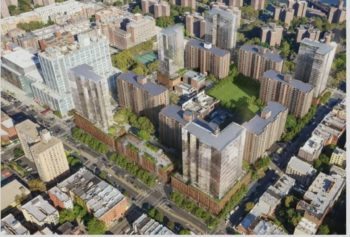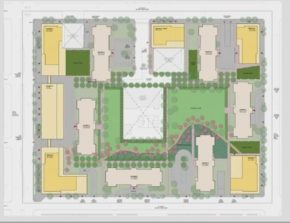
Rendering of Proposed Lenox Terrace Development Image Credit: City Planning
Public appears at public hearing in strong opposition of the proposed redevelopment of Lenox Terrace. On December 18, 2019, the City Planning Commission heard an application by the Olnick Organization to re-zone and re-develop Lenox Terrace. Lenox Terrace is an existing residential development on a twelve acre superblock in the Harlem neighborhood of Manhattan. The block is situated between 135th Street to the north, 132nd Street to the south, 5th Avenue to the east and Malcom X Boulevard to the west. Presenting for the applicants were Ethan Goodman and Elizabeth Bennet of Fox Rothschild LLP and Christopher K. Grabé from Davis Brody Bond.
The applicants propose five new 20-story mixed-use buildings and one 6-story building to be constructed on the vacant portions of the lot or the locations that currently have one-story retail buildings. The decision to build 20-stories was based on the height of the adjacent Harlem Hospital. Between the five new mixed-use buildings, the development will add approximately 1,642 dwelling units with a minimum of 400 to 500 units dedicated to permanently affordable housing.
The lot is currently home to six 16-story residential towers and five one-story commercial buildings, built by Robert Olnick in the late 1950s. Nearly 80 percent or 1300 units in the current buildings are subject to state rent stabilization and tenant protection law. The project area sits between two subway stations and is in a FRESH zone. To the north is the 20-story Harlem Hospital, to the south are 3 and a half story-row houses and 5-story residential and mixed-use building buildings, to the east are the fourteen 6 to 14-story residential, Abraham Lincoln Housing buildings and to the west are predominantly 5-story residential buildings. The lot is currently zoned R7-2 with a C1-4 commercial overlay. R7-2 districts permit medium density residential use and building heights of potentially up to 80 feet. The C1-4 overlay permits the zoning lot’s current ground and first floor commercial and retail uses.
Zoning Actions
The applicants are requesting a zoning map change to a C6-2 district. The applicants believe this commercial zoning designation will give them additional flexibility to lease to retailers of a greater size than is currently permitted under the current zoning scheme. C6-2 districts also permit second floor retail uses where smaller commercial districts and commercial overlays might not. This zoning designation permits building heights up to 21-stories tall and the ability to build the proposed residential units. Technically, with a commercial designation like a C6-2, the owner would still reserve the right to build solely a commercial building. However, the applicants appear totally committed to the mixed-use residences.
As part of the application, the developer also requests a zoning text change to establish a Mandatory Inclusionary Housing (“MIH”) area on the property. The applicants are exploring both MIH Option 1 and Option 2. Either would facilitate the construction of the affordable housing units. The applicants also requested special permits to modify the height, setback and distance between the buildings requirements and to reduce parking requirements. The final zoning action is for additional and wider curb cuts.
Presentation
In the presentation, Goodman, an urban planner, spoke about how this project is not only intended to develop new affordable housing, but also improve the 60 year-old Lenox Terrace apartments. Goodman stated that the Olnick organization is currently in negotiation with the tenants association to make sure that those improvements will also be provided to the existing residents.
Grabé, the project’s architect, laid out the project’s design goals. He first spoke about how the design team worked to complement the existing six residences by making commitments to light, air, visibility and material proportions. According to him, they “did not want to overbuild the lot.”
The second goal purported by the applicants is to create a major green space and move the majority of required parking below grade. The proposed six acres of landscaped green space is currently slotted for the center of the development and would replace the asphalt parking site. The new parking garage will be situated somewhere below ground. In accomplishing these goals and reestablishing a commercial corridor, the applicants desire to interweave the development into the “city fabric” by creating a street wall with safe pedestrian opportunities.
The applicants recognized that there is some concern about the proposed C6-2 district but believe the close proximity to the subway will alleviate the concerns about density and access to transportation. While the C6-2 designation is still their preference, the applicants claim that they will explore a residential equivalent zoning district with a commercial overlay. The applicants also claim that they have every intention to lease the commercial space to smaller retail establishments.

Proposed Site Plan Image Credit: City Planning
Commission Member Comments
Commission Member David J. Burney sought to clarify two aspects of the project. First, confirmed that there will be a total of seventeen curb cuts at the end of the development. He suggested applicants explore thoughtful usages of each cut. Second, he questioned how the green space will be utilized. The team clarified that the green space is not public space and will not be subject to a Parks Department operating agreement. The applicants stated the green space is the property of the owner and would make no further commitments to the space at that time.
Commission Member Michelle de la Uz had questions about the development’s affordability. The applicants again committed to at least 400-500 affordable units, which they point out is beyond the units required under Mandatory Inclusionary Housing. The applicants also voiced an openness to exploring the addition of another building. According to the application team, that building could be composed entirely of affordable units. The applicants believe the building could potentially be situated near 135th Street, specifically the north, central portion of the site.
Commission Member de La Uz also asked about the existence of the sky bridges connecting two of the buildings to the center podium. The center podium is the 6-story building, anticipated to be an important amenity space. Grabé stated that bridges are the width of the corridor and are intended to permit residents to use the amenity space without having to go outside. City Planning Chair Marissa Lago interjected at this point to clarify that the Department of City Planning has advised against the use of the sky bridges in this development.
Other Comments
Manhattan Borough President Gale Brewer recommended disapproval of the application. Brewer purports that a project of this scale is not “responsible” nor a “prudent exercise of planning for future growth.” Borough President Brewer stated a large portion of the units being offered will be market-rate. As a result, Brewer believes it would result in a significant shift in the area’s demographic to residents with higher income levels. Brewer stated “For a century, Harlem has been the epicenter of Black culture in America, but recent real estate trends have resulted in gentrification and led to a decrease in the area’s Black population.”
Community Board 10 in Manhattan voted to disapprove the application by a vote of twenty to fifteen with one abstention. In the report the Community Board wrote about how the development was not consistent with the needs of the community. The Board requested deeper affordability and that building heights not exceed 195 feet.
The public at the City Planning hearing shared many of these concerns. Some community members were concerned that the development was too large and out-of-context with the area. Others were concerned that the market rate rents could displace them from their homes and some added that the local subway platforms might be too narrow for this added density.
The project, if approved, is expected to be completed in two phases. The applicants expect to construct the northwest, southwest and the northeast buildings by 2023. Phase 2 is expected to be completed by 2026 and includes the construction of the north and southeast buildings.
City Planning will vote on the application in the coming weeks. Modifications to the application may happen prior to the vote.
By: Jason Rogovich (Jason Rogovich is the CityLaw Fellow and New York Law School Graduate, Class of 2019)

